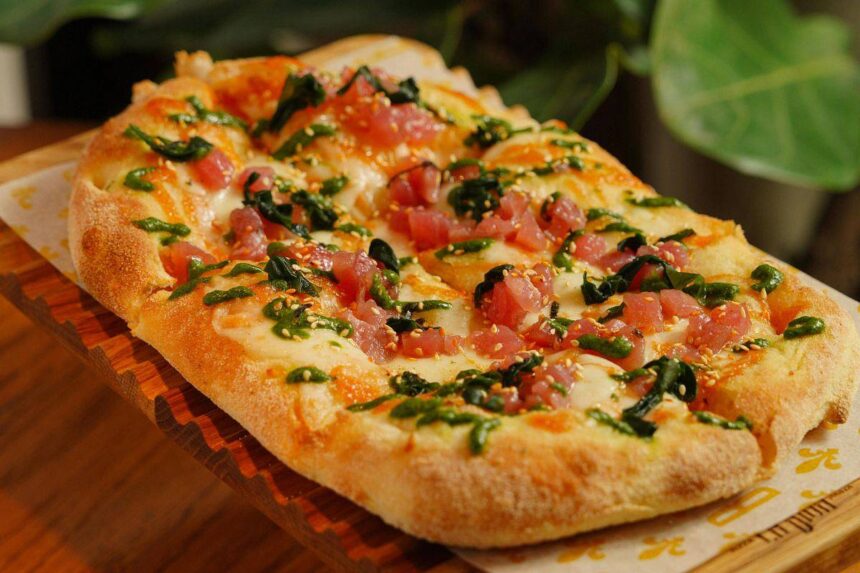/
Rome cannot be recognized only by its monuments or its squares. Sometimes it is a smell that guides us: a crust breaking under your fingers, a fragrant breath that recalls the oven and goodness itself. Pinsa belongs to this sensory universe. It is not pizza, it is not focaccia, but a preparation with a distinct personality. Born from a blend of flours and long fermentation times, it has become the symbol of a surprising lightness, capable of winning over anyone who tastes it.
The beauty of pinsa lies in its balance: crunchy on the outside, soft inside, with airy pockets that hold the toppings like little treasure chests. Today this pleasure is no longer tied only to Roman pinserie (specialized eateries). Precooked bases make it possible to recreate that experience at home, without hours of kneading and waiting, making tradition accessible even to those coming home late in the evening or improvising a dinner with friends.
Let’s see what pinsa is, how to use it with ready-made bases, and why this solution represents the best way to discover — or rediscover — a classic of Roman cuisine with a modern twist.
Pinsa explained simply
Anyone seeing it for the first time immediately notices its shape: oval, thin, with irregular edges that reveal the handmade nature of the dough. Pinsa is born from the union of different flours — wheat, rice, and soy — that give lightness and digestibility. The result is a base that does not weigh you down, with a delicate aromatic profile and a unique texture.
For those who have never kneaded dough, the good news is that today there’s no need to face long leavening times. With a step-by-step pinsa recipe based on precooked bases, everything becomes immediate. The base has already been left to mature for dozens of hours, precooked and packaged to preserve its original characteristics. At home, only one step remains: topping and baking.
In less than ten minutes, a home oven delivers a fragrant pinsa, ready to serve. And here comes the most fun part: creative freedom. Some prefer to stick to the classic tomato and mozzarella, others enrich it with seasonal vegetables, while some experiment with bolder pairings like aged cheeses and honey.
The value of precooked bases
The advantage of ready-made bases is not just speed. Behind every precooked crust lies a precise artisanal process: doughs left to rest for more than 48 hours, shaped by hand or with techniques that respect the structure, and partially baked to lock in fragrance and consistency. In this way, the consumer receives a perfect product that comes back to life as soon as it meets the oven’s heat.
The procedure is disarmingly simple. Preheat the oven to maximum temperature, add your chosen toppings, and wait for the span of a conversation. When the pinsa comes out, the edges are golden and crisp, the center remains soft and moist, ready to support fresh or elaborate ingredients.
Practicality also has a social side: pinsa becomes a dish to share, served in slices while guests help themselves by hand. It suits a last-minute dinner, a quick weekday lunch, or a homemade aperitivo.
From origins to the table
It is often said that pinsa has roots in ancient Rome, but its true story is much closer to us. The modern version was born in Rome thanks to Corrado Di Marco, a baker who developed a special blend of flours (wheat, soy, and rice) and a processing method designed to create a lighter, more digestible dough.
The success was immediate: the crisp crust, the soft interior, and the oval shape made pinsa a recognizable and beloved product. Precooked bases are the natural evolution of this idea, bringing into home kitchens the possibility of preparing it easily without sacrificing quality.
Sitting at the table with a steaming pinsa remains a gesture of conviviality: it is cut, it is shared, it accompanies conversations and simple moments. A recent invention that has quickly entered the Roman — and now international — gastronomic imagination.
The oven heating up, the scent spreading, the crust breaking as it is cut: these are details that transform a daily gesture into a small domestic ritual. In this naturalness, pinsa finds its strength, becoming more than a meal: a moment to remember, to share, to live with lightness.
